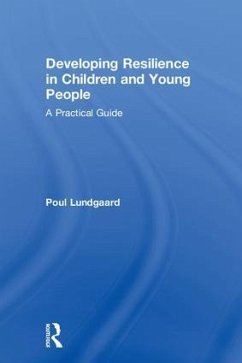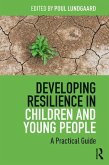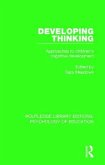- Gebundenes Buch
- Merkliste
- Auf die Merkliste
- Bewerten Bewerten
- Teilen
- Produkt teilen
- Produkterinnerung
- Produkterinnerung
Developing Resilience in Children and Young People is the first book to describe the work of professionals using the world's first mentalisation-based education program.
Andere Kunden interessierten sich auch für
![Developing Resilience in Children and Young People Developing Resilience in Children and Young People]() Poul LundgaardDeveloping Resilience in Children and Young People53,99 €
Poul LundgaardDeveloping Resilience in Children and Young People53,99 €![The Tripartite Matrix in the Developing Theory and Expanding Practice of Group Analysis The Tripartite Matrix in the Developing Theory and Expanding Practice of Group Analysis]() The Tripartite Matrix in the Developing Theory and Expanding Practice of Group Analysis170,99 €
The Tripartite Matrix in the Developing Theory and Expanding Practice of Group Analysis170,99 €![Arts in Nature with Children and Young People Arts in Nature with Children and Young People]() Arts in Nature with Children and Young People170,99 €
Arts in Nature with Children and Young People170,99 €![A for Adoption A for Adoption]() Alison RoyA for Adoption145,99 €
Alison RoyA for Adoption145,99 €![A Psychotherapeutic Understanding of Eating Disorders in Children and Young People A Psychotherapeutic Understanding of Eating Disorders in Children and Young People]() Jeanne MagagnaA Psychotherapeutic Understanding of Eating Disorders in Children and Young People177,99 €
Jeanne MagagnaA Psychotherapeutic Understanding of Eating Disorders in Children and Young People177,99 €![Improving Mental Health Therapies for Autistic Children and Young People Improving Mental Health Therapies for Autistic Children and Young People]() Improving Mental Health Therapies for Autistic Children and Young People165,99 €
Improving Mental Health Therapies for Autistic Children and Young People165,99 €![Developing Thinking Developing Thinking]() Developing Thinking160,99 €
Developing Thinking160,99 €-
-
Developing Resilience in Children and Young People is the first book to describe the work of professionals using the world's first mentalisation-based education program.
Hinweis: Dieser Artikel kann nur an eine deutsche Lieferadresse ausgeliefert werden.
Hinweis: Dieser Artikel kann nur an eine deutsche Lieferadresse ausgeliefert werden.
Produktdetails
- Produktdetails
- Verlag: Taylor & Francis
- Seitenzahl: 172
- Erscheinungstermin: 6. März 2018
- Englisch
- Abmessung: 234mm x 156mm x 13mm
- Gewicht: 440g
- ISBN-13: 9781138236196
- ISBN-10: 1138236195
- Artikelnr.: 57057010
- Herstellerkennzeichnung
- Libri GmbH
- Europaallee 1
- 36244 Bad Hersfeld
- gpsr@libri.de
- Verlag: Taylor & Francis
- Seitenzahl: 172
- Erscheinungstermin: 6. März 2018
- Englisch
- Abmessung: 234mm x 156mm x 13mm
- Gewicht: 440g
- ISBN-13: 9781138236196
- ISBN-10: 1138236195
- Artikelnr.: 57057010
- Herstellerkennzeichnung
- Libri GmbH
- Europaallee 1
- 36244 Bad Hersfeld
- gpsr@libri.de
Poul Lundgaard, MD, Senior Physician, has 25 years of experience working in mental health promotion, especially with children, young people and families. He is the founder of The Resilience Program and is engaged in research building up the evidence base around the program.
A practical guide
to teamwork with children and adolescents
Poul Lundgaard Bak (Ed.)
Table of contents:
Introduction
Chapter 1
What is Resilience? - The Background of tThe Resilience Programme
Poul Lundgaard Bak and Susanna de Lima
Chapter 2
Experiences and results of the Resilience Program for primary school
teachers in Italy
Annalisa Valle, Davide Massaro, Ilaria Castelli,, Francesca Sangiuliano
Intra,
Elisabetta Lombardi, Edoardo Bracaglia and Antonella Marchetti
Chapter 3
Stories and Valuable Questions - Experiences from Health Care
Heidi Moeller Vestergaard and Lene Elmose Broecker
Chapter 4
Resilience at School
The First Experiences
- Resilience for Schools and Children's Groups
Peter Skaarup
Experiences with Resilience in a Socially Disadvantaged School
Dan Henriksen
Luxury Issue? No, Iit's Nnot
Lene Steensberg
Chapter 5
Being Llike the Others - Resilience for Children and Adolescents in Club
Activities
Resilience in a Socially Disadvantaged Residential Area 1
Nina Lykke Nielsen
Resilience in a Socially Disadvantaged Residential Area 2
Tine Kaarup and Nina Lykke Nielsen
Dreams for the Future
Jeanette Corneliussen
Resilience
- 'Only for Paki's?'
Tina Brammer Kristensen, Mette Bentzon and Helle Fogtman Welejus
Resilience in a Youth Perspective
Lotte Dalager
Chapter 6
Resilience for Teenagers in Therapy
A Course for Vulnerable Youths with Drug Abuse Issues
Susanne de Lima with contributions from Lotte Dalager
Cooperating Wwhen Iit's Difficult
Gritt Graugaard Bonde
Chapter 7
Appropriate Challenges in a Special Needs School
Joan Dammeyer
Chapter 8
'Will Yyou Hhelp Mme?' - Experiences from a Children's Home
Louise Kristensen and Mette Haahr
Chapter 9
A Municipal Perspective on Resilience
A Municipal Perspective on Resilience I
Johanne Cecilie Andersen
A Municipal Perspective on Resilience II
Morten Lysdahlgaard
List of Figures (= Figure Texts):
Figure 1.1: Thought bubbles
Figure 1.2: Attention - Spotlight of the brain
Figure 1.3: Focues attention
Figure 1.4: The Thinking Brain and the brains Alarm Centre
Figure 1.5: The Mind game
to teamwork with children and adolescents
Poul Lundgaard Bak (Ed.)
Table of contents:
Introduction
Chapter 1
What is Resilience? - The Background of tThe Resilience Programme
Poul Lundgaard Bak and Susanna de Lima
Chapter 2
Experiences and results of the Resilience Program for primary school
teachers in Italy
Annalisa Valle, Davide Massaro, Ilaria Castelli,, Francesca Sangiuliano
Intra,
Elisabetta Lombardi, Edoardo Bracaglia and Antonella Marchetti
Chapter 3
Stories and Valuable Questions - Experiences from Health Care
Heidi Moeller Vestergaard and Lene Elmose Broecker
Chapter 4
Resilience at School
The First Experiences
- Resilience for Schools and Children's Groups
Peter Skaarup
Experiences with Resilience in a Socially Disadvantaged School
Dan Henriksen
Luxury Issue? No, Iit's Nnot
Lene Steensberg
Chapter 5
Being Llike the Others - Resilience for Children and Adolescents in Club
Activities
Resilience in a Socially Disadvantaged Residential Area 1
Nina Lykke Nielsen
Resilience in a Socially Disadvantaged Residential Area 2
Tine Kaarup and Nina Lykke Nielsen
Dreams for the Future
Jeanette Corneliussen
Resilience
- 'Only for Paki's?'
Tina Brammer Kristensen, Mette Bentzon and Helle Fogtman Welejus
Resilience in a Youth Perspective
Lotte Dalager
Chapter 6
Resilience for Teenagers in Therapy
A Course for Vulnerable Youths with Drug Abuse Issues
Susanne de Lima with contributions from Lotte Dalager
Cooperating Wwhen Iit's Difficult
Gritt Graugaard Bonde
Chapter 7
Appropriate Challenges in a Special Needs School
Joan Dammeyer
Chapter 8
'Will Yyou Hhelp Mme?' - Experiences from a Children's Home
Louise Kristensen and Mette Haahr
Chapter 9
A Municipal Perspective on Resilience
A Municipal Perspective on Resilience I
Johanne Cecilie Andersen
A Municipal Perspective on Resilience II
Morten Lysdahlgaard
List of Figures (= Figure Texts):
Figure 1.1: Thought bubbles
Figure 1.2: Attention - Spotlight of the brain
Figure 1.3: Focues attention
Figure 1.4: The Thinking Brain and the brains Alarm Centre
Figure 1.5: The Mind game
A practical guide
to teamwork with children and adolescents
Poul Lundgaard Bak (Ed.)
Table of contents:
Introduction
Chapter 1
What is Resilience? - The Background of tThe Resilience Programme
Poul Lundgaard Bak and Susanna de Lima
Chapter 2
Experiences and results of the Resilience Program for primary school
teachers in Italy
Annalisa Valle, Davide Massaro, Ilaria Castelli,, Francesca Sangiuliano
Intra,
Elisabetta Lombardi, Edoardo Bracaglia and Antonella Marchetti
Chapter 3
Stories and Valuable Questions - Experiences from Health Care
Heidi Moeller Vestergaard and Lene Elmose Broecker
Chapter 4
Resilience at School
The First Experiences
- Resilience for Schools and Children's Groups
Peter Skaarup
Experiences with Resilience in a Socially Disadvantaged School
Dan Henriksen
Luxury Issue? No, Iit's Nnot
Lene Steensberg
Chapter 5
Being Llike the Others - Resilience for Children and Adolescents in Club
Activities
Resilience in a Socially Disadvantaged Residential Area 1
Nina Lykke Nielsen
Resilience in a Socially Disadvantaged Residential Area 2
Tine Kaarup and Nina Lykke Nielsen
Dreams for the Future
Jeanette Corneliussen
Resilience
- 'Only for Paki's?'
Tina Brammer Kristensen, Mette Bentzon and Helle Fogtman Welejus
Resilience in a Youth Perspective
Lotte Dalager
Chapter 6
Resilience for Teenagers in Therapy
A Course for Vulnerable Youths with Drug Abuse Issues
Susanne de Lima with contributions from Lotte Dalager
Cooperating Wwhen Iit's Difficult
Gritt Graugaard Bonde
Chapter 7
Appropriate Challenges in a Special Needs School
Joan Dammeyer
Chapter 8
'Will Yyou Hhelp Mme?' - Experiences from a Children's Home
Louise Kristensen and Mette Haahr
Chapter 9
A Municipal Perspective on Resilience
A Municipal Perspective on Resilience I
Johanne Cecilie Andersen
A Municipal Perspective on Resilience II
Morten Lysdahlgaard
List of Figures (= Figure Texts):
Figure 1.1: Thought bubbles
Figure 1.2: Attention - Spotlight of the brain
Figure 1.3: Focues attention
Figure 1.4: The Thinking Brain and the brains Alarm Centre
Figure 1.5: The Mind game
to teamwork with children and adolescents
Poul Lundgaard Bak (Ed.)
Table of contents:
Introduction
Chapter 1
What is Resilience? - The Background of tThe Resilience Programme
Poul Lundgaard Bak and Susanna de Lima
Chapter 2
Experiences and results of the Resilience Program for primary school
teachers in Italy
Annalisa Valle, Davide Massaro, Ilaria Castelli,, Francesca Sangiuliano
Intra,
Elisabetta Lombardi, Edoardo Bracaglia and Antonella Marchetti
Chapter 3
Stories and Valuable Questions - Experiences from Health Care
Heidi Moeller Vestergaard and Lene Elmose Broecker
Chapter 4
Resilience at School
The First Experiences
- Resilience for Schools and Children's Groups
Peter Skaarup
Experiences with Resilience in a Socially Disadvantaged School
Dan Henriksen
Luxury Issue? No, Iit's Nnot
Lene Steensberg
Chapter 5
Being Llike the Others - Resilience for Children and Adolescents in Club
Activities
Resilience in a Socially Disadvantaged Residential Area 1
Nina Lykke Nielsen
Resilience in a Socially Disadvantaged Residential Area 2
Tine Kaarup and Nina Lykke Nielsen
Dreams for the Future
Jeanette Corneliussen
Resilience
- 'Only for Paki's?'
Tina Brammer Kristensen, Mette Bentzon and Helle Fogtman Welejus
Resilience in a Youth Perspective
Lotte Dalager
Chapter 6
Resilience for Teenagers in Therapy
A Course for Vulnerable Youths with Drug Abuse Issues
Susanne de Lima with contributions from Lotte Dalager
Cooperating Wwhen Iit's Difficult
Gritt Graugaard Bonde
Chapter 7
Appropriate Challenges in a Special Needs School
Joan Dammeyer
Chapter 8
'Will Yyou Hhelp Mme?' - Experiences from a Children's Home
Louise Kristensen and Mette Haahr
Chapter 9
A Municipal Perspective on Resilience
A Municipal Perspective on Resilience I
Johanne Cecilie Andersen
A Municipal Perspective on Resilience II
Morten Lysdahlgaard
List of Figures (= Figure Texts):
Figure 1.1: Thought bubbles
Figure 1.2: Attention - Spotlight of the brain
Figure 1.3: Focues attention
Figure 1.4: The Thinking Brain and the brains Alarm Centre
Figure 1.5: The Mind game








